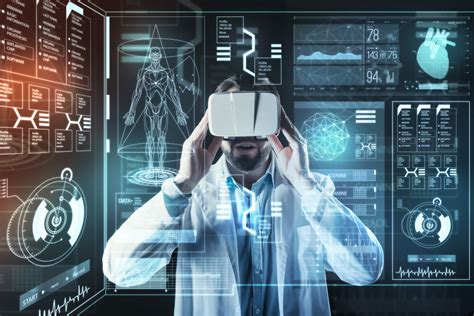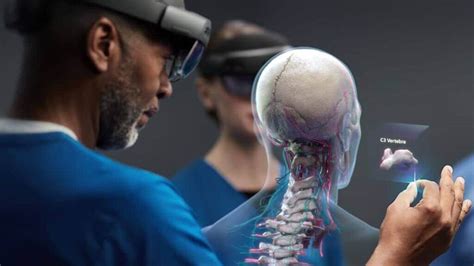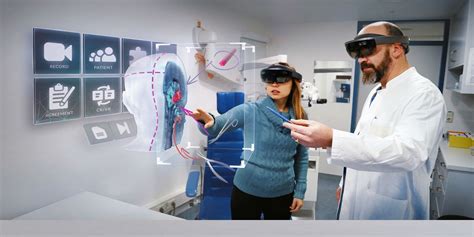Breaking News


Popular News


Learn about the security and privacy risks of augmented reality in healthcare, and find best practices for securing patient data in this evolving industry.As technology continues to advance, the healthcare industry is constantly evolving to incorporate the latest innovations in patient care. One such innovation that has gained traction in recent years is augmented reality (AR). Augmented reality in healthcare has the potential to revolutionize the way medical professionals diagnose, treat, and interact with patients. However, as with any technological advancement, there are inherent security and privacy implications that must be carefully considered.
In this blog post, we will explore the introduction to augmented reality in healthcare and the potential it holds for the industry. We will also discuss the security risks associated with AR, as well as the privacy concerns that arise with the collection and storage of patient data. Furthermore, we will delve into the impact of AR on the healthcare industry as a whole and highlight best practices for securing AR in healthcare settings. Join us as we navigate the complex landscape of augmented reality in healthcare and explore the measures that can be taken to ensure the security and privacy of both patients and medical professionals.
Contents

Augmented Reality (AR) is a rapidly evolving technology that has the potential to revolutionize the healthcare industry. With AR, healthcare professionals can overlay digital information onto the real world, providing immersive and interactive experiences for both patients and practitioners. The use of AR in healthcare can bring about significant improvements in patient care, medical training, and even surgical procedures.
AR applications in healthcare are diverse, ranging from aiding in medical education and training to assisting in surgical planning and visualization. Medical students can benefit from AR by using it to visualize complex anatomical structures in 3D, making it easier to understand and learn. Surgeons can use AR to overlay patient data onto the body during procedures, allowing for more precise and personalized treatment.
Furthermore, the use of AR in telemedicine can help in remote diagnosis and treatment, as well as providing patients with valuable information about their conditions. AR can also be used for rehabilitation purposes, helping patients regain motor functions through interactive exercises and visual feedback. As the technology continues to advance, the potential applications of AR in healthcare are only expected to grow.

Security Risks in Augmented Reality
Augmented Reality (AR) has the potential to revolutionize the way healthcare is delivered, but it also brings with it a host of security risks that need to be carefully managed. As with any technology that involves the collection and sharing of sensitive data, AR systems in healthcare are vulnerable to unauthorized access and cyber attacks. The integration of AR into healthcare settings introduces new challenges and vulnerabilities that need to be addressed to ensure patient data remains secure.
One of the primary security risks associated with AR in healthcare is the potential for unauthorized access to sensitive patient information. In a healthcare setting, AR devices are often used to access and display patient data in real time, creating opportunities for hackers to intercept and exploit this information. As a result, it is crucial for healthcare organizations to implement robust access controls and encryption measures to safeguard patient data from unauthorized access.
Another important consideration is the risk of malicious software and cyber attacks targeting AR devices and systems. As AR technology becomes more integrated into healthcare environments, the potential for malware and other cyber threats to compromise the security of these systems grows. Healthcare organizations must prioritize regular software updates, penetration testing, and employee training to mitigate the risk of cyber attacks and protect patient data from security breaches.
| Security Risks in AR in Healthcare | Strategies to Mitigate Risks |
|---|---|
| Unauthorized access to patient data | Implement robust access controls and encryption measures |
| Malicious software and cyber attacks | Prioritize regular software updates, penetration testing, and employee training |
In conclusion, while AR has the potential to enhance the delivery of healthcare services, it is crucial for healthcare organizations to be aware of the security risks associated with this technology. By implementing stringent security measures and staying vigilant against potential threats, healthcare providers can ensure that patient data remains protected and secure in an augmented reality-driven healthcare landscape.

As the healthcare industry becomes increasingly digitized, there are growing privacy concerns surrounding the patient data that is being collected and stored. With the integration of augmented reality (AR) in healthcare, these concerns are further heightened. Patient data, such as medical history, treatment plans, and personal information, is extremely sensitive and must be protected from unauthorized access.
One of the main worries related to the use of AR in healthcare is the security of patient data. As AR technology relies on various digital platforms and devices, there is an increased risk of data breaches and unauthorized access. Protecting the integrity and confidentiality of patient data is of utmost importance to maintain trust in the healthcare system.
Another challenge is the ethical implications of using AR to access patient data. How can healthcare professionals ensure that patient data is accessed and used in a responsible and ethical manner? It is essential to establish best practices and guidelines for the use of AR in healthcare to mitigate privacy concerns and ensure that patient data is not exploited for commercial or malicious purposes.
In order to address these privacy concerns, healthcare organizations must prioritize cybersecurity measures to safeguard patient data when integrating AR technology. This may involve implementing encryption protocols, access controls, and regular audits to identify and address potential vulnerabilities. Additionally, healthcare professionals and staff should receive training on the responsible and ethical use of AR in handling patient data.
| Privacy Concerns | Security Measures |
|---|---|
| Unauthorized access to patient data | Encryption protocols |
| Ethical use of AR technology | Access controls |
| Data breaches and exploitation | Regular audits and training |

Augmented Reality (AR) has the potential to revolutionize the healthcare industry in numerous ways. One of the key benefits of AR in healthcare is its ability to enhance medical training and education. Medical professionals can use AR to simulate complex surgical procedures, allowing them to practice and refine their skills in a safe and controlled environment. This can result in better outcomes for patients, as surgeons are better equipped to handle challenging cases.
Additionally, AR technology can be used to improve patient outcomes by providing real-time, personalized information to healthcare providers. For example, AR devices can overlay vital signs and patient history directly onto a surgeon’s field of vision during a procedure, reducing the risk of errors and complications. This level of integration and access to patient data can significantly improve the quality of care provided to patients.
Another significant impact of AR on the healthcare industry is its potential to enhance patient engagement and rehabilitation. AR applications can be used to create interactive experiences for patients, such as virtual therapy sessions or immersive educational materials. This can lead to better patient compliance with treatment plans and faster recovery times, ultimately improving the overall healthcare experience for patients.
Moreover, the use of AR in healthcare can also contribute to cost savings and operational efficiency. For example, AR can be used to streamline medical imaging processes, allowing for quicker and more accurate diagnoses. This can lead to reduced hospital stays and lower healthcare costs, benefiting both patients and healthcare facilities.

Best Practices for Securing AR in Healthcare
Augmented Reality (AR) has the potential to revolutionize the healthcare industry, but with this innovation comes security and privacy concerns that must be addressed. As healthcare organizations increasingly adopt AR technology, it is crucial to prioritize data protection to ensure patient confidentiality and prevent unauthorized access to sensitive information.
One of the best practices for securing AR in healthcare is to implement multi-factor authentication for access to AR applications and data. This additional layer of security requires users to provide multiple forms of verification, such as a password, fingerprint, or facial recognition, to access sensitive information. By requiring multiple factors for authentication, healthcare organizations can significantly reduce the risk of unauthorized access to AR systems and patient data.
Another essential practice for securing AR in healthcare is to regularly update and patch AR software and devices to address any security vulnerabilities. Cybersecurity threats are constantly evolving, and outdated software can leave healthcare systems vulnerable to exploitation. By staying up-to-date with security patches and software updates, healthcare organizations can mitigate the risk of potential security breaches and protect patient data from unauthorized access.
In addition to these best practices, healthcare organizations should also implement encryption for AR data to ensure that sensitive information is securely transmitted and stored. Encryption converts data into a code that can only be decoded with the proper key, making it unreadable to unauthorized users. By encrypting AR data, healthcare organizations can safeguard patient confidentiality and protect sensitive information from unauthorized access, helping to maintain the integrity and security of their AR systems.

What are the potential security risks of using augmented reality in healthcare?
Some potential security risks of using augmented reality in healthcare include the possibility of unauthorized access to sensitive patient information, the risk of data breaches, and the potential for malware or hacking attacks on AR devices and systems.
How can healthcare organizations mitigate security risks associated with augmented reality?
Healthcare organizations can mitigate security risks associated with augmented reality by implementing strong encryption measures for data transmission, conducting regular security audits, training staff on security best practices, and ensuring that AR devices and software are regularly updated with the latest security patches.
What are the privacy implications of using augmented reality in healthcare?
The use of augmented reality in healthcare raises privacy concerns related to the collection and storage of patient data, the potential for unauthorized surveillance through AR devices, and the need to obtain informed consent from patients before using AR technology in their care.
How can healthcare providers ensure patient privacy when using augmented reality?
Healthcare providers can ensure patient privacy when using augmented reality by implementing strict data access controls, obtaining explicit consent from patients for any data collection or use of AR technology in their care, and adhering to regulations such as the Health Insurance Portability and Accountability Act (HIPAA) in the United States.
What role does data encryption play in securing augmented reality in healthcare?
Data encryption plays a crucial role in securing augmented reality in healthcare by protecting sensitive patient information from unauthorized access or interception, ensuring the confidentiality of data transmitted via AR devices, and helping healthcare organizations comply with privacy regulations.
Are there any regulations or standards specifically addressing the security and privacy of augmented reality in healthcare?
While there are no specific regulations or standards solely focused on the security and privacy of augmented reality in healthcare, existing regulations such as HIPAA and the General Data Protection Regulation (GDPR) in Europe apply to the use of AR technology in healthcare settings.
What are some potential benefits of using augmented reality in healthcare, despite the security and privacy concerns?
Despite the security and privacy concerns, using augmented reality in healthcare can offer benefits such as improved surgical precision, enhanced training for medical professionals, and the potential for remote medical consultations and diagnoses, which can be especially valuable in underserved or remote areas.